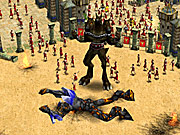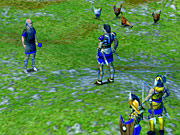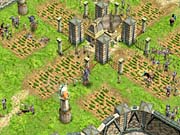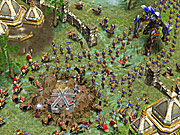Age of Mythology: The Titans Updated Impressions
Ensemble's Bruce Shelley recently showed us the latest version of this upcoming real-time strategy expansion pack. Get the details here.
The original Age of Mythology was a change of pace for the developers at Ensemble Studios. Instead of creating another history-themed real-time strategy game, the developer opted to use a setting based on ancient mythology--a setting that allowed it to draw upon classic Greek, Egyptian, and Norse lore and bring legendary heroes and monsters to life onscreen. The game also gave players the ability to customize their strategies by choosing to worship different minor gods, which would give them different bonuses and different special abilities known as "god powers." Age of Mythology: The Titans will refine the original game by adding an entirely new race, the Atlanteans, and introducing titans, which are new top-level units.

Ensemble's Bruce Shelley was kind enough to pay us a visit earlier this week to give us some background on Age of Mythology: The Titans and show off some of the game's new features. The expansion pack's story picks up where the original Age of Mythology left off, with the destruction of Atlantis. The campaign chronicles how the surviving Atlanteans were able to rebuild their civilization. Over the course of The Titans' 12-episode campaign, you'll become intimately familiar with the unique units and gameplay style of the Atlanteans.
The Atlanteans were designed from the ground up to be an easy race for new or casual real-time strategy players to use. First of all, the Atlanteans' economic and resource model is the least complex of the game's four races, as they do not have to build special resource-gathering structures. While the other three cultures need to build specific structures to collect each resource, the Atlantean citizens themselves are self-contained resource collectors, requiring no special buildings to deposit food, wood, or gold. No time is wasted in transit waiting for Atlantean citizens to drop off their loads, so their overall gathering rate is much faster than the other races' citizens. Furthermore, shifting production is as simple as pulling a citizen off one type of resource and directing it to another--you don't have to worry about building a new resource drop site. To balance out these advantages, Atlantean citizens are more expensive and count as three units against the population cap. While the Atlantean citizens will certainly help reduce micromanagement for casual players, their relative scarcity and value will make them attractive targets for enemies looking to wreak havoc on your economy.

The technology tree for the Atlanteans has been simplified to make it easier for players to remember where certain types of troops are built. The Atlantean barracks are where all basic troops like infantry and archers are built, eliminating the need to create a separate military academy and archery range, as the Greeks do. The "counter barracks," as their name suggests, house all the troop types designed to counter certain units. The Atlanteans' anti-cavalry unit, the katapeltes, is built at the counter barracks, as are the anti-archer and anti-infantry units. Atlanteans also create heroes differently from the other races. You can turn any Atlantean infantry units into heroes simply by expending a certain amount of resources. There's no need to bring them to any buildings or near any other units, so the conversion can be done anywhere, at any time.
Another distinguishing feature of the Atlanteans is that they are allowed to use their god powers more than once, unlike the other three races, which are limited to one use of each god power per match. The more-powerful spells will likely have fewer recharges than the less powerful ones, and Ensemble is adjusting the god powers and units from Age of Mythology's original cultures to ensure that all four races remain balanced. The Atlanteans will also have to endure lengthy cooldown periods between god-power castings.
The Titans in Action
After giving us a bit of background on the game, Shelley loaded up one of the campaign missions to show off a few of the new features. One of them is the repeat button, which is an interface tool that players of any civilization can take advantage of. The repeat button serves as an infinite queue that lets you constantly produce units from a building. It's smart enough to recognize the ordering in a queue, so, for example, you could click on a barrack, select "infantry, archer, infantry," and then hit the repeat button. From then on, that barrack will continuously produce a two-to-one ratio of infantry to archers, in the order specified, until you run short of resources or hit the population cap. At that point, the queue will stall until more resources come in or you build additional housing.

In this particular map, our primary god was Kronos, the god of time. With our initial base trapped behind an impassable mountain, we had to make use of Kronos' special power, "time shift," which lets you move buildings from one part of the map to another. You will need line of sight to the target area in order to activate time shift, and it does take some time for the warp to occur, but time shift makes it easy to hide a barrack or other unit-producing structure in an unexpected area. Shelley also demonstrated another god power, "vortex," which transports all your military units on the map to a single spot. Since it's not necessary to gather up the units into a single area before activation, the vortex power is easy to use, and it could come in handy for emergency base defense. Like time shift, vortex is not instantaneous--it takes some time for all the units to arrive at the target area.
Shelley also showed off the Atlanteans' scout unit, the oracle. Unlike other scout units, the oracle has a tiny sight radius while he's moving. But once the oracle stops, his sight radius gradually expands. Once a stationary oracle's line of sight has expanded as far as it can go, the unit can see across an entire screen's width.
Toward the end of the demonstration, we were finally able to see Shelley demonstrate a few of the game's new titan units in action. Each of the game's four civilizations has one unique titan. All the titans are massive melee combat units that move slowly and inflict incredible damage, and they can also take a lot of punishment, as each one has 7,000 health. That's almost six times as many hit points as the closest comparable unit from the original game, the colossus. As it currently stands, the titans differ primarily in appearance. The Atlantean titan looks like a giant demon made of rocky magma, whereas the Egyptian titan has the head of a bird on a humanoid body. The Norse god looks like a mountain giant who wields a huge hammer, while the Greeks get a three-headed titan. In our demonstration, we were able to watch the Atlantean, Egyptian, and Norse titans beat up on one another, and on lesser units, which tended to go flying when attacked by the behemoths.

Shelley explained that you're allowed to build only one titan, and that creating one is a multistep process that is both expensive and time-consuming. First, your citizens must create a gate for your titan to enter the world. Creating the gate requires plenty of resources, as well as manpower from your citizens. Additionally, the moment you begin construction on a titan gate, your opponents will receive a signal, in much the same way that the game will warn your enemies that you're building a wonder of the world. If you choose to create a titan, everyone will know what you're up to, and where to go to stop it. Once the gate is created, your citizens must spend additional time at the finished structure to open the gate and let the titan in the world. If you're successful, you'll see the giant creature climb up and out of the gate, which looks like a magical, glowing hole in the ground. Though titans themselves are formidable in battle, your enemies might be able to bring in a small army and deal at least some damage to these huge monsters before they emerge, since the slow-moving titans must complete a brief animation sequence when emerging from the gate, during which time they're vulnerable to damage but are not able to counterattack.
Age of Mythology: The Titans is well on its way to completion. Shelley noted that the game is currently feature-complete, and the artwork is almost entirely finished--it only needs some polish on a few of the animations. Currently, the team is putting the finishing touches on the single-player campaign and performing extensive play testing to balance the game's four civilizations. The addition of an entirely new playable race should be enticing to current Age of Mythology players, and the simplified play mechanics of the new Atlantean race may very well attract new players to the game. Age of Mythology: The Titans is scheduled to ship in early October.
Got a news tip or want to contact us directly? Email news@gamespot.com
Join the conversation